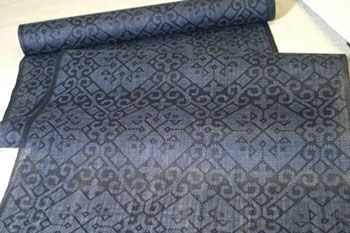Ryukyu indigo dye shortage threatens dye craftsmen

Toshio Nakanishi processing the Ryukyuai grown and transported by contract farmers. Indigo dye is distilled by a fermentation process where the leaves are soaked in water. On May 31 at the Ryukyuai Factory in Izumi, Motobu.
June 7, 2017 Ryukyu Shimpo
By Maki Nagamine
A shortage of Ryukyu indigo, the dye favored for a number of traditional Okinawan dyeing techniques such as bashofu, miyakojofu, and Ryukyu-kasuri has cast a shadow over Okinawa’s artisan community. This is due to factors such as salt damage from typhoons, and the aging of the agricultural community, causing a steep decline in yields for the source perennial crop, called Ryukyuai. The Ryukyuai Factory (Izumi, Motobu), which accounts for over 90% of the dye production in Okinawa, saw a drop in production equal to one-third of the four-ton expected demand in Okinawa for the past two years, and last year they could not avoid adjusting their shipping amount.
The Ryukyuai harvest period occurs twice a year, one in May-June, and the second in October-November. The crop prefers the shade, and is weak to sunlight and high temperatures. The crop is often grown on the slanted surfaces of mountain ravines and requires an abundance of water for raising. The leaf ferments when soaked in water and processed in a state similar to mud or clay before being shipped to textile manufactures.
Leading the shortage are the low-rain typhoons that have struck the northern part of Okinawa’s Main Island in recent years. Salt blown in from the ocean is not washed away by the rain and goes right to the Ryukyuai fields in the ravines, damaging cultivation. The short rainy season two years ago also had a negative effect on the plant’s cultivation.
The Ryukyuai Factory has been digging into the reserves of plants saved up from previous years to make up for the shortage, however they reached the bottom of the reserves in January of last year. Additionally, the farmers contracted to grow the crop continue to retire due to age, and last year’s production fell to 1.4 tons. At the height of demand in the 1970’s the Factory was shipping around seven tons per year.
Toshio Nakanishi, 64, who runs the Factory, reflected, “We had to ship dye with preference to those who had done business with us the longest.” This year, they are looking for farmers to take over for the retired growers and trying to increase farmland, with the goal of achieving a yield of over three tons.
The miyakojofu produced in Miyakojima and Tarama is characterized by its dark indigo color, and uses a lot of Ryukyu indigo. Sachiko Kanzato, head of the Miyako Weaving Co-op, said of the tough situation, “The weavers are feeling the pain of the indigo shortage. We have orders that we are unable to ship, and have asked customers to wait.
(English translation by T&CT and Sam Grieb)

Miyakojofu dyed in dark indigo
Previous Article:Governor Onaga announces lawsuit to demand national government obtain reef crushing permit for Henoko construction
Next Article:Petition to make Dugongs the prefectural animal for Okinawa
[Similar Articles]
- Sugar production season kicks off in Okinawa
- Mikito Ikehara will make indigo dyes in prewar pots he found in Izumi
- Yoshimatsu Higa continues traditional cultivation and production of Ryukyu Dye into its 3rd generation
- Okinawa Prefecture anticipates 30% lower mango production in 2012
- Pumpkin production revives
 Webcam(Kokusai Street)
Webcam(Kokusai Street)


